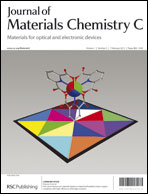Stabilizing blue phases of a simple cyanobiphenyl compound by addition of achiral mesogen monomer with a branched end group and chiral hydrogen-bonded assemblies
Abstract
In this study, we present several simple but effective methods to stabilize blue phases (BPs) and investigate their possible stabilization mechanisms. An achiral mesogen monomer with a branched end group (MF-LCM) and chiral hydrogen-bonded assemblies (CHBAs) were prepared and were applied to extend the BP temperature range of a simple cyanobiphenyl compound (8CB). Increasing the achiral mesogen monomer content results in a widened BP range, which is could be due to molecular shape of the achiral MF-LCM and their interactions with the bulk Ch-LCs molecules. Meanwhile, the result demonstrates that CHBAs also have a positive influence on broadening the BP temperature range, this expansion of the BP temperature range was induced by the chiral effect and viscosity effect. Taking these two factors into account, the widest BP temperature range in the LC sample with MF-LCM and CHBAs was 13.0 °C during the cooling process. Furthermore,


 Please wait while we load your content...
Please wait while we load your content...